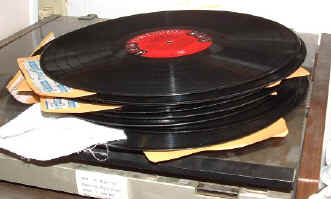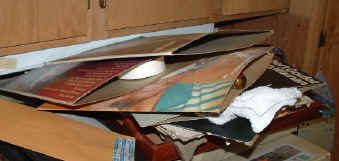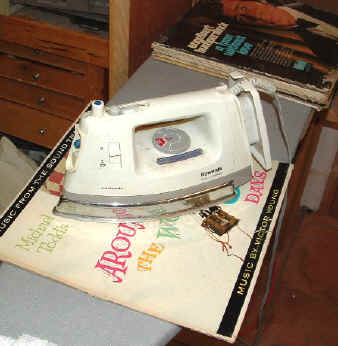One Approach to Record Mold
|
moriemur inultae, sed moriamur.
I will die unavenged, but I will
die.
Aeniad 660 |
By Dominic Vautier
11/2006
I
got a bunch of old LPs from my father-in-law’s estate. I
brought back about 50 of the albums but trashed the other 300 or
so. Believe me they were real moldy and I was afraid to even get
the stuff anywhere close to my “good” records. I
did notice however that the records cleaned up well with the usual detergent
soap and hand scrubbing procedure.
I had to wash the bad records a few times. Mold did
not seem to effect the vinyl. The
jackets were another issue altogether because mold gets into paper
record covers and cardboard jackets easily. I discarded the record
covers and washed the jackets inside and out with a rag soaked
with about 20 percent bleach (be sure to use a surgical glove). Sometimes I
had to cut open the jackets to completely clean them. Bleach kills
just about all kinds of mold spores. I then ironed the jackets to get
them flat again and kill any remaining spores. I installed new envelopes.
The results were not bad if you want to go to all the trouble to restore
moldy records. The records were recordable to CD but not in
excellent shape.
 First I removed the records from their moldy
jackets, cleaned them in warm water and detergent hand soap. I then
dried them off and stacked them up, a dozen or so at a time. I
allowed them to dry, inspected them and washed a few again.
First I removed the records from their moldy
jackets, cleaned them in warm water and detergent hand soap. I then
dried them off and stacked them up, a dozen or so at a time. I
allowed them to dry, inspected them and washed a few again.
 The jackets were a mess. I cleaned them off inside
and out with a solution of bleach and dried them off as best I could. I had to cut
some open. Others just fell apart.
The jackets were a mess. I cleaned them off inside
and out with a solution of bleach and dried them off as best I could. I had to cut
some open. Others just fell apart.
After cleaning, I used the linen, cotton
temperature on the iron with no steam. It goes to about 220 degrees; the hottest
temperature kills mold spores.

 After ironing the jackets I weight them down
for about 24 hours or so to get them flat again. I then taped up the sides where needed.
If you get new inner covers get the plastic
kind. you may want to get plastic outer jacket covers too.
After ironing the jackets I weight them down
for about 24 hours or so to get them flat again. I then taped up the sides where needed.
If you get new inner covers get the plastic
kind. you may want to get plastic outer jacket covers too.
 First I removed the records from their moldy
jackets, cleaned them in warm water and detergent hand soap. I then
dried them off and stacked them up, a dozen or so at a time. I
allowed them to dry, inspected them and washed a few again.
First I removed the records from their moldy
jackets, cleaned them in warm water and detergent hand soap. I then
dried them off and stacked them up, a dozen or so at a time. I
allowed them to dry, inspected them and washed a few again. The jackets were a mess. I cleaned them off inside
and out with a solution of bleach and dried them off as best I could. I had to cut
some open. Others just fell apart.
The jackets were a mess. I cleaned them off inside
and out with a solution of bleach and dried them off as best I could. I had to cut
some open. Others just fell apart.
 After ironing the jackets I weight them down
for about 24 hours or so to get them flat again. I then taped up the sides where needed.
If you get new inner covers get the plastic
kind. you may want to get plastic outer jacket covers too.
After ironing the jackets I weight them down
for about 24 hours or so to get them flat again. I then taped up the sides where needed.
If you get new inner covers get the plastic
kind. you may want to get plastic outer jacket covers too.